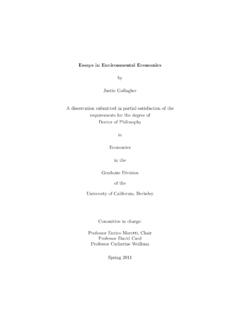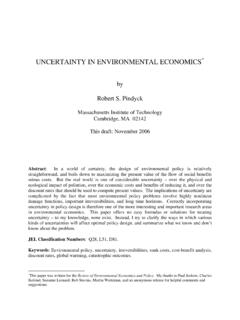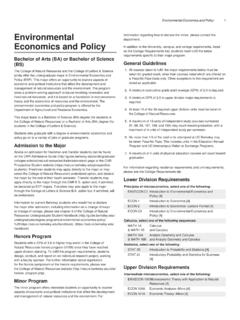Transcription of Syllabus: Environmental Economics - Cornell University
1 1 AEM 4510 / ECON 4820 Cornell University Shanjun Li Spring 2014 syllabus : Environmental Economics Time: TuTh 2:55PM - 4:10PM Location: Malott Hall 251 Professor: Shanjun Li 405 Warren Hall (this is the designated course email address) Office Phone: 607-255-1832 Office Hours: Tu 4:20-5:00PM at 405 Warren Hall and by appointment TA: Joel Landry office hour and location: Friday 2-4, 434 Warren Hall. Course Summary This class will focus on the role of the environment in the theory and practice of Economics .
2 It will make use of microeconomic and statistical analysis at the intermediate level and will incorporate real-world examples. The class will be divided into two parts. Part I will cover the ways in which markets fail to efficiently allocate resources in the presence of pollution along with the class of Pigouvian policies used to correct those failures. Part II will focus on the empirical techniques used by economists to put values on Environmental commodities. Knowing these values is a precondition for properly applying the policies described in Part I.
3 Prerequisites You should have completed Calculus and intermediate microeconomics courses (MATH 1110 and ECON 3130) before taking this class. Ideally, you will also have completed or concurrently take at least one of the econometrics courses such as AEM 4110 (Introduction to Econometrics), ECON 3200 (Introduction to Econometrics), and ECON 3210 (Applied Econometrics). Requirements The following are required for successful completion of the course: (1) two theoretical problem sets covering theoretical concepts, (2) a short paper on hydraulic fracturing for shale gas extraction.
4 (3) a short empirical project designed to illustrate the endogeneity of many Environmental taxes (and to teach some basic empirical skills), (4) a group empirical project in which you will implement a non-market valuation technique (a theoretical project or literature review can be used in lieu of the empirical project if you desire to do so), and (5) class participation. We will have a number of in-class activities that are intended to keep things from getting boring. These sorts of activities generally work best if everyone comes prepared and participates.
5 There will also be opportunity for participation in the course of normal lectures. 2 Grading Grades will be determined based on the following allocation: Class participation (all in-class activities) 10%; two theoretical problem sets 20%; short paper (Fracking) 20%; short empirical project (endogenous taxation) 10%; group empirical/theoretical Project 40%. All of these assignments are distributed at the start of the semester so you can begin to work on them as soon as you want. All the assignments except the group project are individual assignments and you are expected to turn in your individual answers.
6 Plagiarism will not be tolerated. Group Project You are expected to work on the group project in a group of 3-5 students. You need to form your group and inform my TA Joel at about the members of your group no later than March 29th, 2014. If you have trouble forming the group, email Joel before the deadline so that he can be an eHarmony for you. For the group project, a list of topics and potential data sources are posted on the blackboard under the Group Project folder which itself is under the Administration folder. Alternatively, I encourage you to come up with your own topic and collect your own data.
7 One way to do that is to read recent literature from major Environmental economic or general economic journal ( , Journal of Environmental Economics and Management, Review of Environmental Economics and Policy, American economic Review, Quarterly Journal of Economics ) that discusses a very specific Environmental issue with economic consequences. The final products will be a 15-20 minutes class presentation (divided equally among the members) and a paper between 8-15 pages not including references but everything else (font 12 and double spacing). The group presentations will be held during the last 3 lectures or so.
8 The grade for the group project will be based on both the presentation and the paper itself. The group paper should have the following five sections: 1. Summary: a maximum of 1 page summary of your paper (be sure to include names of all authors) 2. Introduction. Please include the following subsections: (1) What is the issue (define the problem), and (2) why is this issue important? One way to establish your argument in the second subsection is to include quotes from major newspapers or magazines, such as the New York Times or the Wall Street Journal or the Economists, or some quote by some major public figure (politician etc.)
9 That discusses the problem. 3. economic analysis and findings. For an empirical project, this section should include data and empirical model. For a theoretical paper, it should include a theoretical model or theoretical arguments and derivations. Findings should be presented here. 4. Conclusion. Discuss briefly what lessons we can learn from the study ( , policy suggestions). 5. References. List all the references used in your article. The paper has to be submitted in electronic format to no later than 12PM on May 15th (late submission will not be accepted).
10 3 Readings The required textbook for the class is Keohane and Olmstead, Markets and the Environment (Island Press, 2007) Other sources of optional readings are: Matthew Kahn, Fundamentals of Environmental Economics : Solving Urban Pollution Problems (Kindle Edition, available from at $2.) Charles Kolstad, Environmental Economics (Oxford University Press, 1st edition 2000, or 2nd edition 2010) The RFF Reader in Environmental and Resource Policy (Wallace Oates Editor, 2nd edition 2006, RFF Press) The second optional book is more expensive and is placed on reserve at Mann library.









